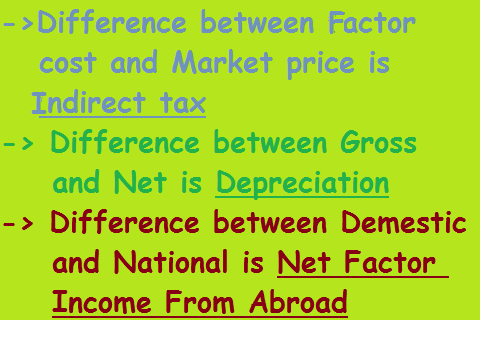National Income and Related Concepts

Introduction to the Concept of National Income
Now, we are comparing and ranking countries based on their economic activities and social progress. National Income accounting is one of the most important concepts in the field of Macro Economics. The accounting and finding of an economy’s national output is more important, especially after the Keynesian revolution in Economics, after the phenomenon of great depression of 1930s.
Now, counting, comparing and predicting future of an economy is very difficult. When we observe an economy, we will have so many economic activities like production, consumption, saving, investment etc. By definition, national income is the total money value of the entire economic activities in an economy during a specified period of time.
To explain the complexity of measurement of the value of national income, economists explained it very systematically. For simplicity, according to economists, the entire economic activities may come from four sectors of an economy.
a) Individual consumers (C )
b) Businesses / investments (I)
c) Government sector (G)
d) Foreign sector / export and import (X or X-M)
National income has been defined by many professionals with different views. But theoretically, all definitions are giving same meaning. The father of modern national income accounting, Simon Kuznets defined “National income is the net output of commodities and services flowing during the year from the country's productive system in to the hands of the ultimate consumers”
Before going to learn the major concepts of national income, it will be better to understand the following items.
What is Net Factor Income from Abroad?
Now, all the economies interact with other economy. So, there will be inflow and outflow of output. Net Factor Income From Abroad means the net amount of factor income received from abroad over factor income paid to foreign sector through the foreign sector. When an international transactions occur between two countries, there will be either monetary or commodity flows or both. Sending of remittances by non-residents to their home country is a factor income. So there will be both sending and receipts for each country.
Anyway we can find out the Net Factor Income from Abroad by using the following formula.
Net Factor Income from Abroad = factor income received from abroad – factor income paid to abroad
What is Depreciation?
Depreciation is defined as the permanent and gradual reduction in the value of assets due to wear and tear, use or abuse or impact of time.
What is Subsidies?
Subsidies refer to the amount given by the government sector for the public or for industries to minimize the cost of production.
What is Taxes?
A tax refers to the amount paid to the government by individuals and producers etc. Mainly there are two types of taxes such as Direct taxes and Indirect taxes.
What is Transfer Payments?
Transfer Payments are made by government to individuals and others. Actually it will be for unproductive activities such as subsidies, pensions etc
Main concepts of National Income Accounting
Following are the major concepts in the national income accounting.
I) National income at current prices and constant prices
II) National income at factor cost and market prices
III) Gross National Product (GNP)
IV) GNP Deflator
V) Net National Product (NNP)
VI) Gross Domestic Product (GDP)
VII) Gross Domestic Product (GDP) and Gross National Product (GNP)
VIII) Net Domestic Product (NDP)
IX) Gross National Product (GNP) Deflator
X) Green GNP
XI) Per Capita Income
XII) Private Income
XIII) Personal Income
XIV) Personal Disposable Income
I - National income at current prices and constant prices (nominal and real prices)
National income is the money value of an economy’s activities. it can be measured either at current year prices or constant year prices.
National income at current or nominal year prices refers to measure the value of an economy’s activities on the basis of the price level of the existing time. In other words, counting of the value of goods and services at a price by goods and services are produced.
National income at constant or base year prices refers to the measuring of national income on the basis of a base year price (base year is a previous year, normally base year is fixed by Economists and policy makers, base year is fixed on the condition of favorable period and the year should not witness any kind of economical or political or social problems like natural calamities, war etc). Compared to the measuring national income at current year prices, base year accounting will be better. Because the constant priced national income can be used to compare between years. Moreover it can be used to analyze the changes in price level in an economy.
II - National income at factor cost and market prices
The value of an economy's output can be measured at market prices and factor costs also.
In an economy, we can see the presence of taxes and subsidies. It will impact the price of an output in two ways. Taxes increase the prices of commodities and subsidies reduce the prices of commodities.
When we measure national income at market prices, taxes and subsidies influence the price as said above. We can measure national income at market prices by multiplying the quantity of output with the market prices of that output. The Net Factor Income from Abroad should also include in the national income when we measure at market prices.
Another way of measuring national income is on the basis of factor costs. We can derive national income at factor cost by adding the cost occurred during the production time on different factors of production like land, labor, capital etc. So, the following formula can be used to find national income at factor costs.
National income at factor cost = national income at market prices – net indirect taxes + subsidies
III - Gross National Product (GNP)
Gross National Product (GNP) is the market value of all final goods and services produced by a country during a year. The GNP includes the value of output produced in abroad. Further the value of depreciation is also included in GNP. We can derive GNP by using the following formula
GNP = GDP + Net Factor Income from Abroad
Nominal GNP = It is the final value of goods and services of a country measured at current year prices
Real GNP = It is the value GNP measured at base year prices. So, it is measured at fixed prices.
Potential GNP = It is the value of GNP, when the country produced its output by using all the available resources. This means fuller utilization of resources.
Actual GNP = It is the value of GNP actually produced. In almost all the economies we can not see potential GNP. Because there is a possibility for the under utilization of resources, because many problems may exists in each economy like unemployment, low capacity of labor power etc.
GNP Gap = GNP Gap refers to the difference between Potential GNP and Actual GNP. So,
GNP Gap = Potential GNP – Actual GNP
IV - GNP Deflator
GNP Deflator is an important concept in macro economics to measure the general price level in an economy. GNP deflator is the ratio of nominal GNP and real GNP.
I.e, GNP deflator = Nominal GNP / Real GNP
V – Net National Product (NNP)
NNP is the total value of all the final goods and services produced by a country during a specified period excluding depreciation. So, we can derive NNP from GNP by deducting depreciation.
Mathematically,
NNP = GNP – Depreciation
VI – Gross Domestic Product (GDP)
GDP is the total money value of all final goods and services produced within the domestic territory of a country. The contribution of foreigners into production or output is also included in GDP.
Potential GDP = It refers to the value of output of a country resulted by the optimum utilization of the available resources.
Actual GDP = It is the value of a country’s output for a specific period of time produced actually.
GDP Gap = It is the difference between Potential GDP and Actual GDP. I.e.
GDP Gap = Potential GDP – Actual GDP
VII – GDP and GNP
GDP Refers to the domestic output and GNP mean the output of a country produced irrespective of domestic or foreign country. The major difference between GDP and GNP is foreign sector, which is the Net Factor Income from Abroad.
VIII – Net Domestic Product (NDP)
NDP is the total money value of all the final goods and services produced within the domestic territory of a country during a specified period by excluding the amount of depreciation. So,
NDP = GDP – Depreciation
IX – Green GNP
Green GNP is one of the new concepts of national income accounting. GNP may not give the actual amount of national income. The reason is that, sometimes after the counting of national income, the country may loss something in the forms of natural depletion. Green GNP can be derived after deducting the value of natural depletion from GNP.
X – Per Capita Income
Per Capita Income is the average income of people of a country in a particular period. It can be calculated by dividing the national income of the country by total population. Mathematically,
Per Capita Income = national income / population
This concept can be used to know the average income of the people of a country and their standard of living. But it has some limitations also, For example. Per capita income can't taken as a tool to measure inequality.
XI – Private Income
Private Income refers to the income earned by individuals and other private corporate from their economic and non-economic activities irrespective of domestic territory or foreign territory. So, transfer payments like scholarships, pensions etc. included in Private Income.
XII – Personal Income
Personal Income is the income received by individuals of a country from all the sources. It can be calculated by using the following formula.
Personal Income = Private Income – undistributed profits – profit taxes
XIII - Personal Disposable Income
Personal Disposable Income is the amount of income of individuals which can spend for consumption and savings. Entire Personal Income cannot spend as they wish. The reason is the influence of taxes. Individuals can spend their income only after the payment of direct taxes. So, Personal Disposable Income can be arriving by using the following formula.
Personal Disposable Income = Personal Income - Direct Taxes

Conclusion
National Income is one of the wide concepts in Macro Economics. Simply national Income accounting means the measurement of the money value of the economical activities or output of an economy for a specific period of time. The most significance of national income accounting is, it enables the economists or the authority of a country to understand and alter the required changes in the country's policy. Moreover it can be used for comparison purpose also.








